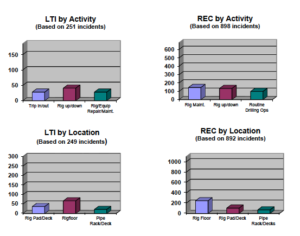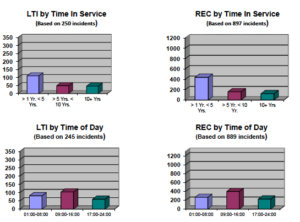2016 ISP: Global LTI, recordable incident rates both down, but number of fatalities ticks up slightly
Worldwide LTI rate improves by more than 27% while recordable rate improves by nearly 24%; 9 fatal incidents were reported, compared with 8 in 2015
By Kelli Ainsworth, Associate Editor

Numbers from the latest IADC Incident Statistics Program (ISP) are encouraging. The ISP, which has tracked safety and accident information for the drilling industry since 1962, shows that the worldwide lost-time incidents (LTI) rate improved by 27.7% from 2015 to 2016, going from 0.18 to 0.13. The recordable incident rate also saw improvement, falling by 23.3% from 0.60 in 2015 to 0.46 in 2016.
“The drilling industry’s efforts toward safety have resulted in the industry’s occupational LTI incidence rate to improve from more than 14.00 in 1963 to 0.13 in 2016, which is a 107-fold improvement,” said Rhett Winter, IADC’s Director of Onshore Operations.
Although the industry saw fewer LTI and recordable incidents in 2016, fatalities increased slightly, from eight in 2015 to nine in 2016.
The ISP report is based on incident rates, which are calculated on incidents per 200,000 man-hours. During 2016, 95 contractors participated in the ISP. These contractors worked a total of 396.2 million man-hours, compared with 500.6 million man-hours worked in 2015. In total, these companies reported 909 recordable incidents and 254 LTIs.
Fatalities

Out of the nine fatalities that were reported in 2016, four involved employees with more than one but fewer than five years of service. Two of the fatalities occurred during rigging up or rigging down operations, with additional fatalities occurring during riser handling, equipment maintenance, mud mixing/pumping, BOP stack installation or maintenance, casing or tubular running, and well testing. Eight of the fatalities were “struck-by” incidents, and one was a “caught-between” incident. By occupation, Drillers and Assistant Drillers accounted for four of the nine fatalities.
By Region
US
Together, US land and offshore contractors worked 62 million man-hours with four fatalities.
Three of these fatalities occurred onshore, where contractors worked a total of 34 million man-hours. The LTI rate for US onshore worsened in 2016, rising by 12.9% from 0.31 in 2015 to 0.35. US onshore contractors saw a small improvement in their recordable incidence rate, which fell by 1.6% from 1.22 in 2015 to 1.20 in 2016.

Offshore contractors logged 27.8 million man-hours and had one fatality. The LTI rate for US offshore is down by 25% from 2015, falling from a rate of 0.12 to 0.09. The total recordable incident rate also improved from 0.56 in 2015 to 0.49 in 2016, which is a decrease of 12.5%.
Europe
Drilling contractors in Europe worked a total of 68 million man-hours in 2016 with one fatality, which occurred onshore.
Onshore contractors worked 40.2 million man-hours in 2016. They saw their LTI rate increase by 13.3%, from 0.15 in 2015 to 0.17 in 2016. The recordable rate remained steady at 0.23.
Offshore Europe accounted for 28.5 million man-hours worked and no fatalities. The LTI rate improved by 36.8%, from 0.19 in 2015 to 0.12 in 2016. Recordable incident rates also improved, decreasing by 20.6% from 0.63 in 2015 to 0.50 in 2016.
Canada
Canadian contractors worked 2.29 million man-hours in 2016 with no fatalities.

Onshore contractors in the region accounted for 746,000 man-hours. Their LTI rate rose significantly, from 0.14 in 2015 to 0.54 in 2016, which is an increase of 285.7%. Their recordable incident rate improved slightly from 1.36 to 1.34, for a 1.5% reduction.
Offshore contractors in the region fared better. They worked 1.5 million man-hours and held their LTI rate steady at zero. The recordable incident rate for Canadian offshore improved by 67.5%, from 0.80 in 2015 to 0.26 in 2016.
Central America and Caribbean
Contractors in Central America and the Caribbean worked a total of 4.7 million man-hours with no fatalities.
Onshore contractors logged 1 million man-hours and lowered their LTI rate by 43.9%, from 0.98 in 2015 to 0.55 in 2016. The recordable incident rate for the region’s contractors worsened slightly. It rose from a rate of 1.59 in 2015 to 1.64 in 2016, for a 3.1% increase.
Offshore, drilling contractors in Central America and the Caribbean worked just over 3.6 million man-hours. Their 2015 LTI rate of 0.18 fell by 38.9% to 0.11 in 2016. The recordable rate in the region also improved, dropping by 45.9% from 0.61 in 2015 to 0.33 in 2016.
Africa

There were no fatalities reported by African contractors, who worked a total of 38 million man-hours in 2016. Both onshore and offshore contractors improved their LTI and recordable rates.
Onshore contractors accounted for 17.9 million man-hours and saw notable improvements to both their LTI and recordable rates. The LTI rate improved by 71.8%, from a 2015 rate of 0.39 to a 2016 rate of 0.11. Similarly, the recordable incident rate improved by 66.4%, falling from 1.16 in 2015 to 0.39 in 2016.
Offshore contractors in the region accounted for 20 million man-hours worked and made similar safety gains. In 2016, the LTI rate for the region was 0.01, which represents an 88.9% improvement from the 2015 rate of 0.09. The recordable incident rate fell as well, from 0.34 in 2015 to 0.20 in 2016, a 41.2% improvement.
Middle East
This region accounted for more man-hours than any other, with a total of 149 million. Three fatalities occurred in the Middle East in 2016, all of which were onshore. However, LTI and recordable rates for the region improved both onshore and offshore.
The Middle East’s onshore contractors worked 100 million man-hours and improved both their LTI and recordable rates. LTI rates decreased by 7.1%, from 0.14 in 2015 to 0.13 in 2016. Recordable rates for Middle East onshore fell by 18.3%, from the 2015 rate of 0.60 to a rate of 0.49 in 2016.
Offshore contractors logged a total of 48 million man-hours. The LTI rate of 0.10 in 2015 decreased to 0.05 in 2016, for a 50% improvement, while the recordable rate improved by 16.1%, from 0.31 in 2015 to 0.26 in 2016.

Asia Pacific
A single fatality was reported in this region, where contractors worked 43.4 million man-hours. The region’s sole fatality occurred offshore.
Onshore, which accounted for 9 million man-hours, both the LTI and recordable rates improved. The 2015 LTI rate of 0.11 fell by 36.4% to 0.07 in 2016. Even bigger improvements were made to the recordable incident rate, which dropped by 47.1%, from 0.34 in 2015 to 0.18 in 2016.
However, incident rates increased offshore, which accounted for 34.4 million man-hours. The LTI rate rose from 0.05 in 2015 to 0.11 in 2016, a 120% increase. For recordable incidents, the rate rose by 30.4%, from 0.23 in 2015 to 0.30 in 2016.
South America
There were no fatalities among South American contractors, who worked 23.8 million man-hours in 2016.
The region’s onshore contractors accounted for 11.9 million man-hours. Their LTI rate worsened slightly, rising by 8% from 0.25 in 2015 to 0.27 in 2016. The recordable incident rate for South American onshore contractors increased slightly from 0.72 in 2015 to 0.71 in 2016, a difference of 1.4%.
Offshore contractors worked 11.9 million man-hours and improved their LTI rate by 54.5%, decreasing it from 0.22 in 2015 to 0.10 in 2016. Likewise, the recordable rate fell by 34.6% from 0.52 in 2015 to 0.34 in 2016.
Australasia
Drilling contractors in the Australasia region worked 3.8 million man-hours without any fatalities.
This region’s onshore contractors, who improved both their LTI and recordable incident rates in 2016, accounted for 1.3 million man-hours. The LTI declined from 0.15 in 2015 to zero in 2016. Australasia’s recordable incident rate improved, as well, decreasing by 9.4% from 0.53 in 2015 to 0.48 for 2016.
Offshore, the region’s contractors worked 2.5 million man-hours and saw an LTI rate of zero, down from 0.10 in 2015. The recordable incident rate for Australasia offshore contractors was reduced from 0.55 in 2015 to 0.48 in 2016, a 12.7% improvement. DC





